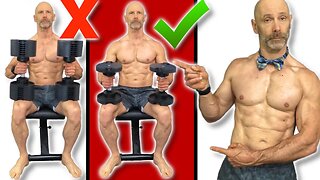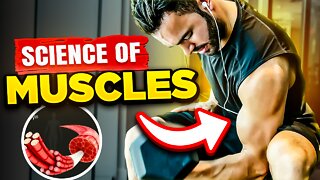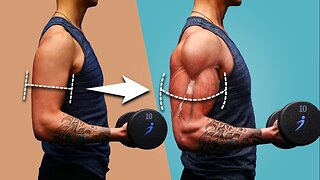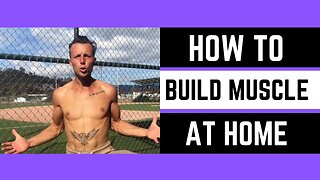Not Building Muscle? Get Your Priorities Straight (Muscle Growth Pyramid)
In 2020 I made a muscle growth priority pyramid, and today we’re going to tear it apart. Reorganize it and add some things in.
The idea behind this isn’t so we can have a pretty chart we can post on social media. It’s to get us thinking about our training, where the weak links are and what we can do to fix them.
We’re going to start at the bottom and work our way up. I’ve often said consistency is the foundation of muscle growth. If we’re not training consistently, then we aren’t going to build muscle.
That said, we can consistently train once a month, maybe even 2 or 3 times a month, but that’s not enough. We need a greater frequency than this.
This is why I’m moving frequency to the bottom of the pyramid. I’m going to replace its old spot with something else.
If you are interested in losing body fat and adding muscle, please email me at 1shark1bite@gmail.com for information on my personal training services.
Here is the link to FortisFight https://www.fortisfight.com/product-category/men/ and use my affiliate discount code FITAND50 at checkout for 15% off you next purchase on all of their apparel.
If you would like a set of Torrobands for yourself, here is my affiliate link so you can receive 50% off on your purchase https://sale.torroband.com/?affId=555B3E5D
Check your testosterone levels from home. Just click this link http://trylgc.com/laurence and receive 30% off with code: LAURENCE30 I receive commissions on referrals to LetsGetChecked. I only recommend services I know and trust.
My Affiliate link to Lebert for their Equalizer bars and more; https://lebertfitness.com/?ref=FitAnd50 and use the discount code FITAND50 you will receive 20% off your purchase
Facebook; https://www.facebook.com/Fit-and-50-5...
My Amazon page link; https://www.amazon.com/shop/fitand50
You need to train a muscle group at least once a week, and twice is even better. The more frequently we train, the more it increases our weekly training volume. So it’s time to move to the next level.
I’m keeping volume and intensity here as they are like the siamese twins of muscle growth. When building muscle, volume without intensity is a waste of time. And intensity needs some degree of volume for growth. You can’t just do your one rep max on the squat, bench and deadlift every day and think you’re going to build muscle.
Training intensity is often defined as a percentage of your one rep maximum. I prefer to look at intensity as how close you train to failure: another way to word this reps in reserve.
For example, if you’re training with a weight that brings you to failure at 12 repetitions, but on each set, you only do 5 reps leaving 7 in reserve. This isn’t enough intensity to build muscle.
The general rule of thumb is you need to be within at least 3 or 4 repetitions from failure to build muscle.
Volume is often defined as sets x reps x weight or load. The problem with this is the same as with intensity. It doesn’t recognize how close to failure these sets are. Most studies look at volume as the number of sets done close to failure.
So how many working sets per body part per week should we be doing for maximum muscle growth? The truth is the more volume we can do and fully recover from is what will build the most muscle.
This is why I’m adding recovery to this layer of the pyramid. It’s the limiting factor to how much volume and intensity we can train within a given week.
The most significant factors affecting recovery are sleep, nutrition, stress and training experience. Nutrition is important enough that it should have its own spot on the pyramid. But I wouldn’t put it before progression because no matter how perfect your diet is, if you aren’t training, then you won’t build any muscle. Nutrition alone doesn't build muscle.
To continue to grow, we need to make our training progressive. There are 3 main ways we do this.
The most basic is called linear progression. This is when we simply add weight to the bar over time.
The most common one is called double progression, where you gradually increase the number of repetitions you’re doing within a range, say 8 to 12. Once you can do 12 repetitions, you increase the weight and start back at 8 reps, and as you get stronger, you slowly work your way back up to 12.
The final way is triple progression, where you not only increase the weight and repetitions but also the number of sets you do.
The basic movements need to train our whole body are a squat, a pressing move, a row, and a deadlift.
I’d add a vertical pull which would include pull-ups or lat pull downs, and do both a horizontal press like the bench press and a vertical press like a shoulder press.
A example of this is the chest also brings our arm a cross our body so it makes sense to include chest flyes into our programming.
This is where I’m adding in nutrition. It could be argued that nutrition is important enough that it should get its own pyramid and be set right next to this one.
-
 4:41
4:41
Fit and 50
1 year agoBest Ways To Build Muscle Without Lifting Heavier (12 ways)
471 -
 10:23
10:23
UnlimitedHustle
1 year ago $0.01 earnedMuscle Building Basics And The Science Behind Gaining Muscle (Explained in 3 stages)
117 -
 4:04
4:04
NewAge Workout
8 months ago5 Muscle Building "Secrets" No One Talks About!
75 -
 9:01
9:01
DIYContent
1 year agoHow To FORCE Muscle Growth (5 Science-Based Methods)
35 -
 5:13
5:13
NewAge Workout
2 months agoHow To Make Pushups Harder (Build More Muscle)
40 -
 0:44
0:44
Healthy Habits: Your Guide to a Better Life
1 year agoGaining Muscle Mass: Recipes to Help You Build Muscle
11 -
 2:33
2:33
OfficialHiFitLife
1 year agoHow to build muscle from home
29 -
 0:09
0:09
INCVBATOR
1 year agoHow to Gain Muscle FAST in the Description
1 -
 0:15
0:15
INCVBATOR
1 year agoHow to Gain Muscle FAST in the Description
1 -
 0:07
0:07
INCVBATOR
1 year agoHow to Gain Muscle FAST in the Description
2